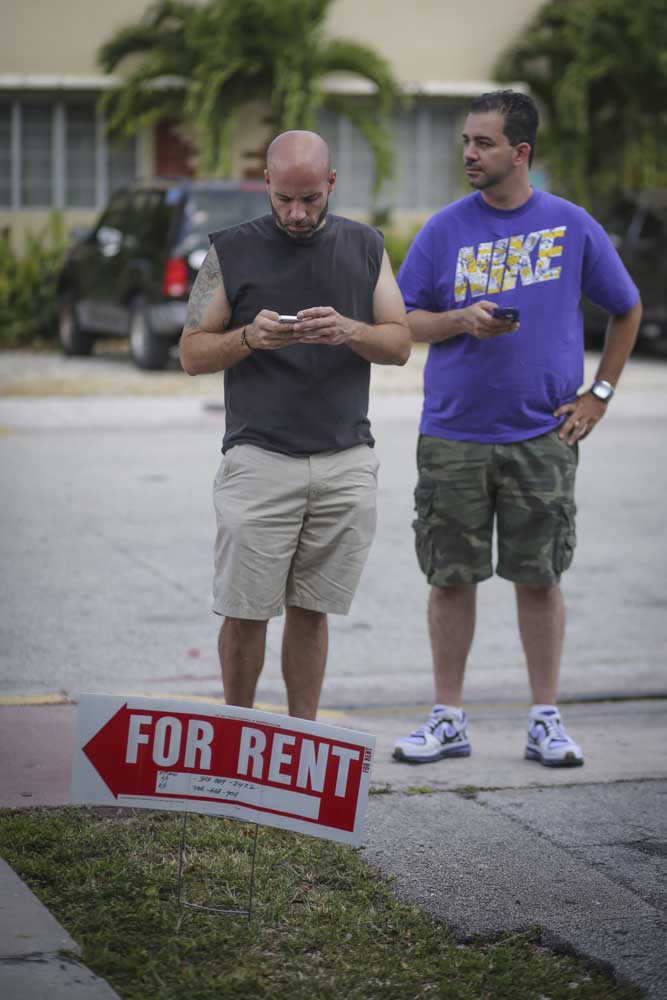Rising costs put squeeze on renters
Published 12:00 am Tuesday, April 15, 2014

- Angel Valentin / New York Times News ServiceArturo Breton, left, and Aurelio Medina consult their smartphones as they look for an apartment to rent earlier this month in Miami Beach, Fla. “I’ve come down to the conclusion that in this country, it’s easier for two people to pay the rent than for one person,” Breton said.
MIAMI — For rent and utilities to be considered affordable, they are supposed to take up no more than 30 percent of a household’s income. But that goal is increasingly unattainable for middle-income families as a tightening market pushes up rents ever faster, outrunning modest rises in pay.
The strain is not limited to the usual high-cost cities like New York and San Francisco. An analysis for The New York Times by Zillow, the real estate website, found 90 cities where the median rent — not including utilities — was more than 30 percent of the median gross income.
In Chicago, rent as a percentage of income has risen to 31 percent, from a historical average of 21 percent. In New Orleans, it has more than doubled, to 35 percent from 14 percent. Zillow calculated the historical average using data from 1985 to 2000.
Nationally, half of all renters are now spending more than 30 percent of their income on housing, according to a comprehensive Harvard study, up from 38 percent of renters in 2000. In December, Housing Secretary Shaun Donovan declared “the worst rental affordability crisis that this country has ever known.”
Apartment vacancy rates have dropped so low that forecasters at Capital Economics, a research firm, said rents could rise, on average, as much as 4 percent this year, compared with 2.8 percent last year. But rents are rising faster than that in many cities even as overall inflation is running at little more than 1 percent annually.
One of the most expensive cities for renters is Miami, where rents, on average, consume 43 percent of the typical household income, up from a historical average of just more a quarter.
Stella Santamaria, a divorced 40-year-old math teacher, has been looking for an apartment in Miami for more than six months.
“We’re kind of sick of talking about it,” she said of herself and fellow teachers in the same boat. “It’s like, ‘Are you still living with your mom?’ ‘Yeah, are you?’ ‘Yeah.’”
After 11 years as a teacher, Santamaria makes $41,000, considerably less than the city’s median income, which is $48,000, according to Zillow.
Even dual-income professional couples are being priced out of the walkable urban-core neighborhoods where many of them want to live. Stuart Kennedy, 29, a senior program officer at a nonprofit group, said he and his girlfriend, a lawyer, will be losing their $2,300 a month rental house in Buena Vista in June. Since they found the place a year ago, rents in the area have increased sharply.
“If you go by a third of your income, that formula, even with how comfortable our incomes are, it looks like it’s going to be impossible,” Kennedy said.
Part of the reason for the squeeze on renters is simple demand — between 2007 and 2013 the U.S. added, on net, about 6.2 million tenants, compared with 208,000 homeowners, said Stan Humphries, the chief economist of Zillow.
For many middle- and lower-income people, high rents choke spending on other goods and services, impeding the economic recovery. Low-income families that spend more than half their income on housing spend about a third less on food, 50 percent less on clothing, and 80 percent less on medical care compared with low-income families with affordable rents, according to a new report by the National Low Income Housing Coalition. And renters amass less wealth, even nonhousing wealth, than homeowners do.
The problem threatens to get worse before it gets better. Apartment builders have raced to build more units, creating a wave of supply that is beginning to crest. Miami added 2,500 rental apartments last year, and 7,500 more are expected in the next two years, according to the CoStar Group, a real estate research firm.
But demand has shown no signs of slackening. And as long as there are plenty of upper-income renters looking for apartments, there is little incentive to build anything other than expensive units. As a result, there are in effect two separate rental markets that are so far apart in price that they have little effect on each other.
Cities have been left to address the problem on their own, with some granting exceptions to their own zoning laws to allow for things like micro-apartments. Miami has allowed some variances to its urban plan for projects like Brickell View Terrace, which will have 176 units in a prime location near a Metrorail station. Ninety of the units will be affordable for people making 60 percent of the median income, 10 for people making less, and the rest will be market rate.
But a seemingly insatiable demand for luxury condos in Miami, created in part by wealthy Latin Americans, has caused land prices to soar, making affordable housing projects harder to build anywhere close to downtown. Moving farther out is cheaper, but the cost savings on housing can be quickly wiped out by transportation costs. A 2012 study by the Center for Housing Policy found that Miami was the most expensive metropolitan area in the country when housing and transportation costs were combined.






